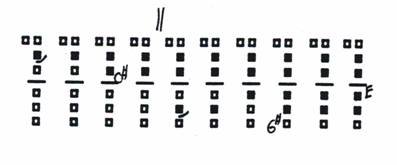Introduction:
The acoustical design of the modern bass clarinet permits and promotes several unique sonic qualities (found in conventional sounds) from which many of today's new techniques have been derived. First, it allows an incredible range of colors, not only throughout its range, but on every pitch! These are apparent not only in single sounds, but in multiple sounds as well. It is ironic that the standard trend in bass clarinet performance practice has been towards timbric homogeneity (a goal that is impossible to attain!)! Secondly, the instrument is capable of a broad range of dynamics, from the virtually inaudible to ff. Finally, the instrument lends itself to extremes of technical activity (with regard to speed, register, and density of pitches) and, therefore, a broad range of different musical characters. Many composers, during the last twenty-five years, have "extended the techniques" of players simply by writing virtuosic music involving conventional sounds (i.e. many fast notes with rapid register leaps and extreme dynamic contrasts). The struggle of the performer attempting to realize this music has produced its own type of "new" musical interest and "new" techniques.
The Bass Clarinet of the Twenty-First Century has one main objective as a representative of a fourth generation of studies on extended instrumental techniques - to expand the sonic resources of the bass clarinet based on peculiarities of its acoustical design, and of its current performance tradition: a wedding of theory and practice. The need for this has been especially supported by the author's experience in performing or reading countless new works that utilize new techniques for the bass clarinet in an awkward fashion, or that do not take musical advantage of some inherent strengths of the instrument. Charts of new sounds have been included, based on acoustical principles of the bass clarinet. It is hoped that this approach will help to overcome the idiosyncratic and empirical nature of earlier studies.
As a prelude to Chapter I, some general acoustic principles that the bass clarinet illustrates are presented, along with a brief theory of bass clarinet technique. The theory is based on a variety of teaching methods and concepts, including those of William Powell , Leon Russianoff, William Kincaid (John Krell), and George Townsend. This theory encompasses current ideas on connections between physical movement and legato technique, tempered by various acoustical considerations. It is believed that by connecting characteristics of methodologies of standard technique with the exploration of new techniques, one can successfully unlock further, reliable new techniques in a systematic fashion. Throughout The Bass Clarinet of the Twenty-First Century an effort has been made to involve fingerings that are closest to standard patterns. One example of this relationship can be found in the ordering of practical microtonal segments; these are most successful when they involve chromatic fingerings of the right and left hands that lead from below to one of the twelve tones. In effect, the bass clarinetist need only learn a couple of variations of the standard chromatic fingering (Example #1).
Example #1

Chapter I is concerned with "Single Sounds." These are divided into three main categories: alternate fingerings (with an emphasis on the altissimo register), quarter-tones (including some easy conjunct segments), and microtones. One-hundred eighteen microtones (including quarter-tones) and one-hundred forty-two alternate fingerings are discussed in The Bass Clarinet of the Twenty-First Century in terms of acoustical origin, timbre, dynamic range, response, and stability.
Chapter II is entitled "Multiple Sounds." Three-hundred eighteen multiphonics and multiple sonorities are classified according to property (overtones or undertones), in practical sequences (according to identical left hand, or "short tube" fingerings), by pitch (bottom), timbre (texture), dynamic range, response, stability, and whether they are possible to attack with either their top or bottom pitches alone, with a gradual fade-in of their other voices. Multiphonic trills are also briefly examined.
The third chapter is comprised of discourse, musical examples, and charts on other new clarinet resources that are not part of Chapters I and II. These include sounds of definite pitch and sounds of indefinite or ambiguous pitch (noise and pitch approximation). There is no end to the possible "other" clarinet sound resources, and this chapter does not pretend to do more than touch the surface in a very personal fashion.
Composers and bass clarinetists who plan to utilize some of the information presented in The Bass Clarinet of the Twenty-First Century must be aware that all of the examples and charts were compiled from research undertaken with the standard Boehm-system bass clarinet (Buffet Prestige) in B-flat, and represented here at WRITTEN PITCH . Application of this information to other clarinet systems has not been attempted. Other complete studies would be required to determine what information is adoptable. However, since an overwhelming majority of American student and professional bass clarinetists play standard Boehm-System instruments, the practical value of this data can be substantial.